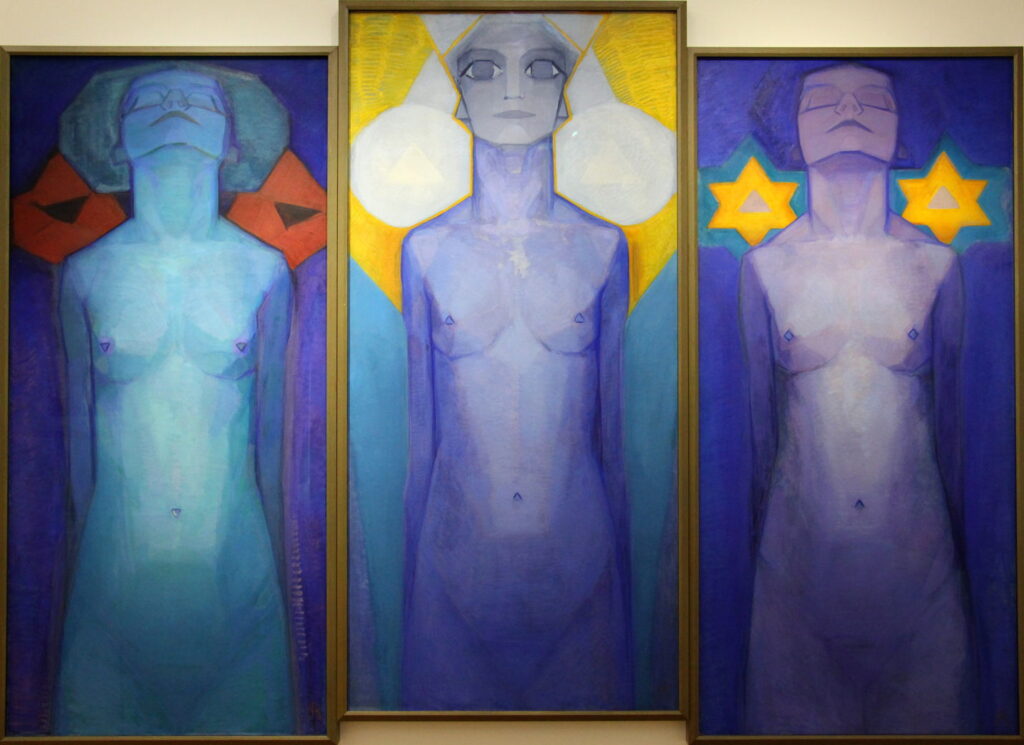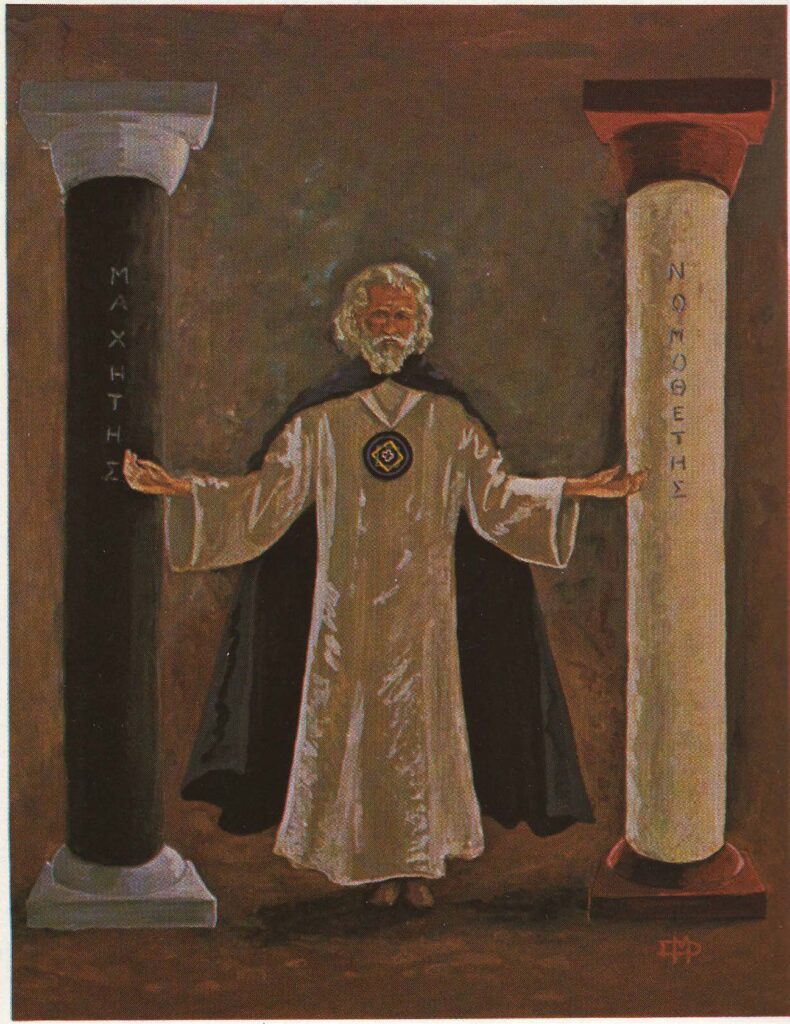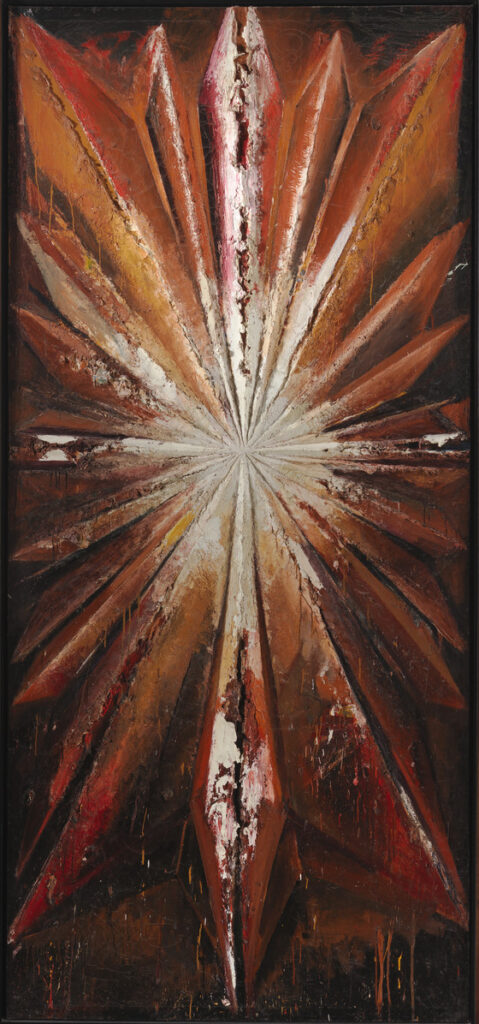
‘Consistit columna in barathris…’
This post is the last of a series on the foundational rituals of the Ogdoadic tradition, a form of western ritual magic described by Melita Denning and Osborne Phillips in their Magical Philosophy series. This system was taught and practiced by the Aurum Solis under their leadership, and remains so by the Astrum Sophiae and other orders today.
The Clavis Rei Primae (CRP) is often understood as our version of the Stella Matutina’s Middle Pillar. The comparison is fair. The CRP is, properly, a suite of rituals which awaken, strengthen, and transform the Body of Light. It is key to the magician’s development (it means ‘key of the first things’). Our focus here is on the first formula of the CRP, also called ‘The Rousing of the Citadels’: the magician draws a current of light down through six psychic gate-centres, then passes two whirling currents of force around the central column. The House of Adocentyn has published the instructions in full.
Denning and Phillips stress the importance of this rite. Many of our rituals involve moving power through the central column of the magician’s subtle body; in this rite they are progressively awakened and energised. As they put it, bluntly: ‘without stimulation of the Centres of Activity, the aspirant will have no personal power and, consequently, a technique requiring, for example, a balanced and concentrated radiation of force from his psyche would be of little use to him.’ (III. p 201)
Mastery (and regular practice) of the Rousing is thus essential for magical development. Its depths continue to unfold even for the advanced student, where its theurgic aspect comes into play. It is the awakening of divine power within the body of the magician, the blossoming of the wand, the column in the deep, the river of light, the alchemy of the Body of Light. I believe this form is one of the great secrets of the tradition, hidden in plain sight.
The Shining Body
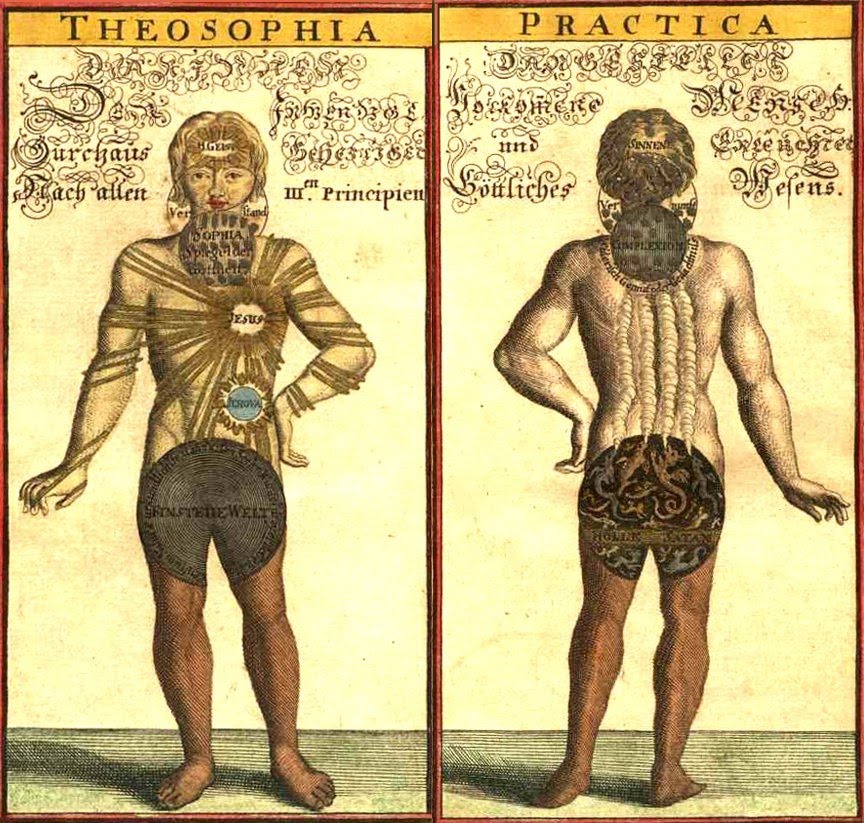
The history of the subtle body, or the Body of Light, in western esotericism is an extremely complex and ramified topic. It stretches from the ancient Platonic soul vehicle to the elaborate astral schematics of Theosophical doctrine. Full consideration of this fascinating conceptual history will have to wait for another time, although Simon Cox’s superb recent study deserves many readers. (It is notable also for freely and pleasingly troubling the divide between scholar and practitioner.)
For our purposes it is enough to say the following:
- Human beings possess a subtle body.
- This subtle body is responsive to directed intention, breath and imagination.
- The subtle body is a mirror of the cosmos: everything without can be found within.
- Certain points or centres within the subtle body correspond to particular forces, often latent in the waking psyche.
- Repeated training of the subtle body can awaken those latent powers.
- Training of the subtle body alters and transforms it permanently.
The Rousing is a meditative, embodied ritual form of the axiom ‘as above, so below’. Like Hermes singing of the ‘powers within me’ on the mountain, it invokes divine virtues to stir their counterparts in the human soul: it is thus a work of internal, psycho-spiritual alchemy.
Some claim these techniques entered occultism from yogic and tantric sources (and thus should be discarded as inessential). They certainly bear the marks of the centuries-long cultural exchange with the east. Yet allusions to similar practices can be found among the ancient theurgists, who speak of drawing down light and the irradiation of the subtle body. For Iamblichus, father of theurgy, opening the subtle body to possession (κατοχή, katochē) or transformative contact (σύστασις, sustasis) with divine light was the point of theurgic prayer.
Iamblichus gives us a neat summation of the purpose:
“Extended practice of prayer nurtures our intellect, enlarges very greatly our soul’s receptivity to the gods [τὴν δὲ τῆς ψυχῆς ὑποφοχὴν τῶν θεῶν ποιεῖ λίαν εὐρυτέραν], reveals to men the life of the gods, accustoms their eyes to the brightness of divine light, and gradually brings to perfection the capacity of our faculties for contact with the gods, until it leads us up to the highest level of consciousness (of which we are capable); also, it elevates gently the dispositions of our minds, and communicates to us those of the gods, stimulates persuasion and communion and indissoluble friendship, augments divine love, kindles the divine element in the soul [τόν τε θεῖον ἔρωτα συναύξει, καὶ τὸ θεῖον τῆς ψυχῆς άνάπτει], scours away all contrary tendencies within it, casts out from the aetherial and luminous vehicle surrounding the soul everything that tends to generation, brings to perfection good hope and faith concerning the light; and, in a word, it renders those who employ prayers, if we may so express it, the familiar consorts of the gods.”
[De Mysteriis: 238.12-239.10, in Clarke, Dillon & Hershbell’s translation, p.277. Emphasis mine.]
Enlarging the ‘carrying capacity’ of the soul through repeated invocation of divine powers is a frequent concern of Iamblichus’s. He suggests it leaves behind a spiritual residue perceptible in the life (or even the physical appearance) of the individual – like a self-renewing virtuous cycle. It prepares the soul for the experience of the Holy Guardian Angel: a gradual opening to self-divinisation. The serenity and attentiveness which are so often the marks of the committed practitioner, not notably common in modern occultism, come to mind here.
Iamblichus gives us other hints. First, there is a purgative aspect to this work. Purification of this kind is an essential part of our work, especially in the early stages. This is not mortification, but practice of the Rousing should restore inner order and communication between various levels of the psyche (including the transpersonal). Our culture works very hard to keep us agitated and overstimulated, so we inhabit ourselves less and less. Solid magical training burns off some of this dross.
The second is his emphasis on virtuous life. In the millennium and a half since, ethical reflection has become severed from magical instruction. The fruits of this divergence have been dubious at best. As the Rousing really begins to work, it will exert an ethical pressure on the life of the magician. (Initiation accelerates this process.) It is obviously no real use maintaining a spiritual practice for, say, half an hour a day if we spend the rest of our time undermining it, or living in contradiction to it. It can’t be sustained. This is not a plea for unworldly asceticism, or false virtuousness, or to pretend human lives do not involve pain or difficulty. But the poison (pharmakon) of our pain may be transmuted into a medicine (pharmakon) by our work. Such a transformation was once reputed to be a power of the Holy Grail.
The Form and Purpose
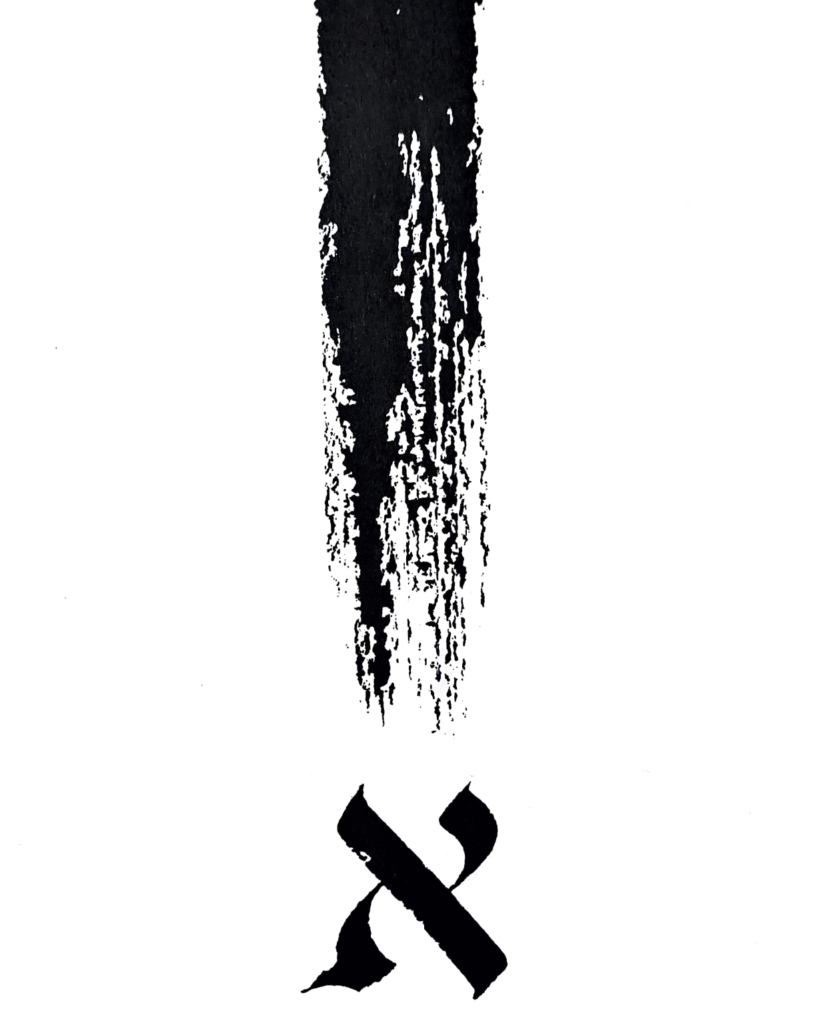
The first form of the CRP calls divine power down through the gate-centres of the subtle body, in a channel which runs down the front of the body, then sends power whirling up in a caduceus around that central column. Proficiency in this technique is the basis for all other developments, including the second form, which moves power down through the central core of the body and in a reflux current back to the heart. This is also a basis for works of magical transmission and consecration.
In a profound and insightful article on the CRP in The Ogdoadic Journal, William Stoltz (former Grand Master of the Astrum Sophiae) compares the forms of the CRP with the channels of Daoist internal alchemy. Two insights are worth stressing: first, the efficacy of the first form increases in power over time, in response to the increasing capacity of the practitioner. (So it is unlikely to blow your head apart.) Second: an analogue of the rising ‘kundalini’ experience can be found in the assumption of the winged serpent godform of the Agathodaimon, a technique quite capable of producing ecstatic consciousness. (As in the completion of the advanced ritual The Gnostic.)
It is worth mentioning that some classical Tantric texts speak of the kundalini as a coiled sprout of flame dwelling in the heart; others speak of an upper and lower kundalini which must be joined at the heart. Though we are not a Tantric tradition, there is a striking resonance here: the alchemical unification of higher and lower, and their transmutation at the heart centre. As a very different text puts it: ‘It ascends from the earth to the heaven and again it descends to the earth and receives the force of things superior and inferior.’
Careful integration of breath, body and visualisation mark the development of this technique, and we lay out a gradual pathway of visualisation to allow a novice to master the skill. Maintaining these visualisations can be hard work at first, but the aim should be a state of confident, attentive openness, allowing the mind to rest completely in the quality of each centre in turn.
Some students are daunted by learning complex, sustained visualisation. But this is a work of recovery, reawakening capacities which sit latently within us, and all human beings: we can be confident, therefore, that it is within our capacity even when slow and difficult. Thus Iamblichus speaks of an innate gnosis (ἔμφυτος γνῶσις, emphutos gnōsis) waiting to be uncovered within us.
These are not mindless technical drills. We invite real spiritual forces through our breath – that most intimate and fundamental of activities – to take up residence in the body and transform us. That is a reason to approach the practice with sincerity, joy and openness. When Moses saw the burning bush, a perfect image of the transforming fire – associated with the revelation of the divine name traditionally associated with Kether (אֶהְיֶה, Ehyeh) – he was instructed to remove his sandals because he was stood on holy ground. To stand in the presence of holiness requires us to make ourselves joyously vulnerable, barefoot and open to transformation.
A Ladder of Lights
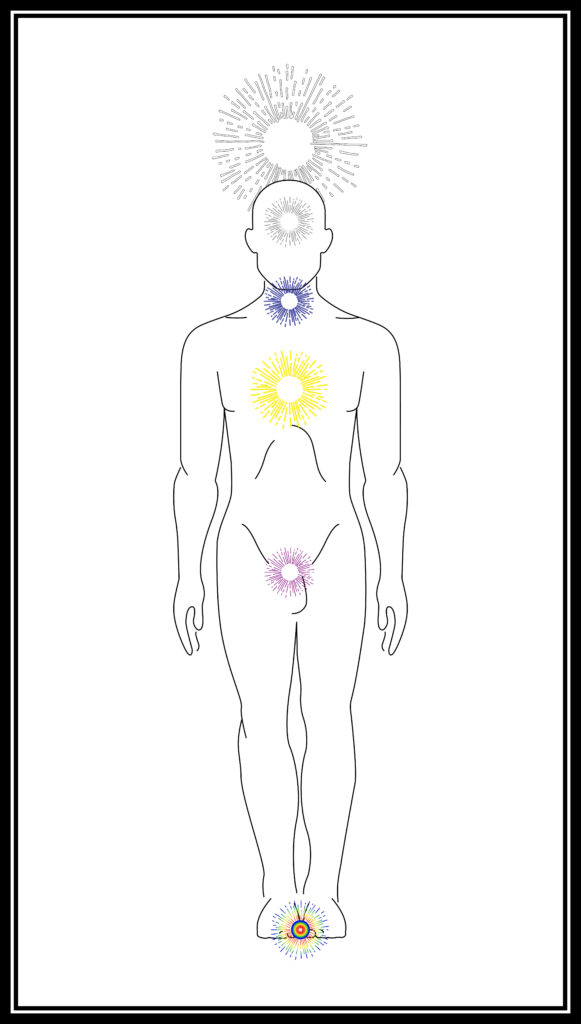
Rather than replicate all the information about the subtle centres available elsewhere, I offer some reflections of the forms of consciousness and principles associated with them. (We are instructed to reflect briefly on each centre after they are established; I find myself ‘resting’ in each of the centres.) Repeated practice of the Rousing opens new facets of these spheres, even after many years of familiarity.
A technical note on colours and movement: the colours given to the spheres are drawn from the four A.S. colour scales. The centres as evoked in CRP-1 form the composite tree, i.e., comprising the four Qabalistic worlds; the combination of these scales make the rite very potent. The top three (crown, brow, throat) are drawn from the Radical scale, the utterly transpersonal and divine world of Atziluth. The heart centre in the Prismatic scale, and the world of Briah; the genital centre in the Contingent scale, for the astral world of Yetzirah; the earth centre between the feet in the Iconic scale, for Assiah. This is a good image of the human soul: a ladder of lights which spans all the worlds. The movements attributed to each (pulsing, billowing etc) also reflect certain qualities of the spheres.
Corona Flammae
Crown of Flame: Kether
The ultimate divine spark in each being: the light it can bestow is limitless, and virtually all workings of the A.S. begin with it. It is stark holiness itself. Kabbalists attribute various paradoxical or apophatic qualities to it. Crowley says rightly, “it cannot be touched, it cannot be extinguished, in no way can it change; for it is utterly apart from all those things which have dimension, which have complexity, which change and may be changed.”
The first Ode of Solomon – an ancient collection of hymns, perhaps bearing gnostic influence – puts it thus: “The Lord is on my head like a crown, and I shall never be without Him. / Plaited for me is the crown of truth, and it caused Your branches to blossom in me.” The image of the tree blossoming within is a perfect representation of the fruits of the Clavis.
It scarcely needs saying that to visualise and attune the mind to a principle is hardly to attain full consciousness of that sphere, and this is especially so for the transpersonal spheres. (This is what the myth of Semele, who beheld her divine lover unveiled and was consumed, teaches us.) Yet each sephirah exists in all worlds at once, and to visualise the Keter centre is to begin to open our awareness of it, however imperfectly and distantly, and discern its power moving within us.
Uncia Coeli
A Twelfth-part of Heaven: The Supernals; Binah.
(‘Uncia’ ultimately gives us our word ‘inch’; Denning and Phillips draw attention to the Byzantine artistic tradition of marking a square inch on the forehead of the elect. ‘Twelfth-part’ might be understood to refer to the Zodiac, and the individuation of the soul as it descends into incarnation.)
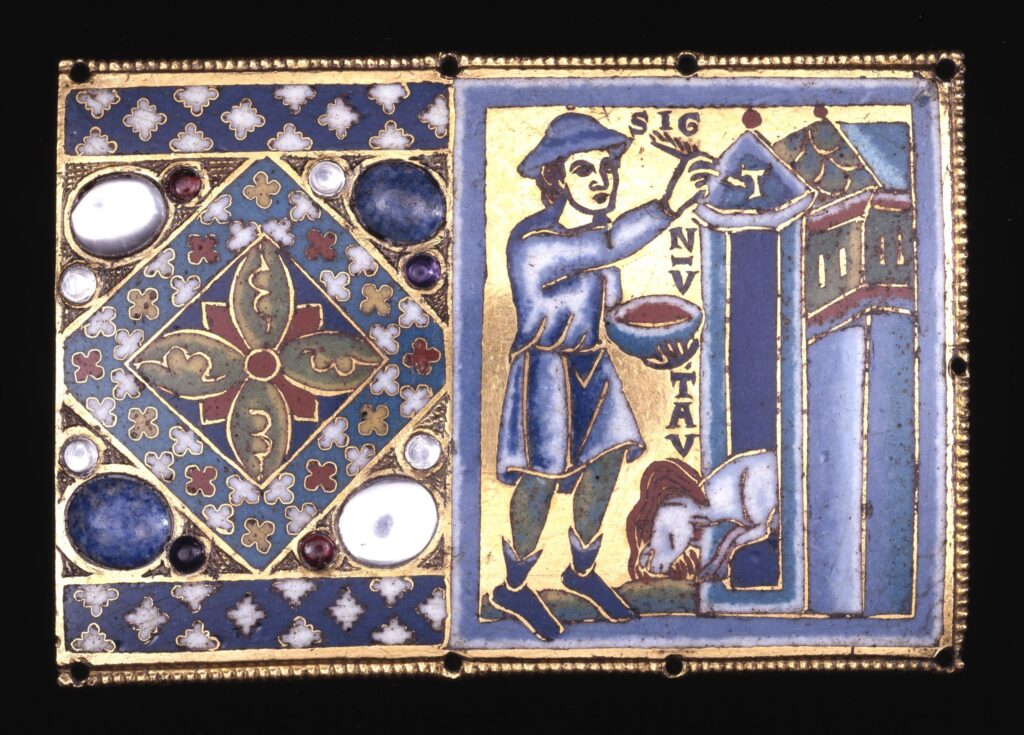
Inclusion of the brow centre is unusual in magical tradition. The authors stress its importance: it ‘resolves and intensifies’ the power from the Corona Flammae, and represents the influence of the supernal powers in the individual. It is the seat of the higher intuition, or Neshamah. The opening of the rational mind to this superconscious presence is a central part of the Ogdoadic magician’s path. Its magical image – the Celestial Queen – and Divine Name emphasises this is the sphere of the Great Goddess. The Kabbalists sometimes conceive of Binah as a mighty river, from which flow the seven streams of the lower sephiroth – a powerful image for this rite, which draws down a great river of light.
The infinite compassion and wisdom of the primordial mother is perhaps the most attractive aspect of this sphere, but its severe, ascetic and Saturnine face is of equal importance. Both aspects – the Dark and Bright Mother – help balance the solar centre, which ceremonial magic, ill-pursued, can excite to messianic narcissism. The brow centre is also the place of anointing and consecration: the magician is making himself a consecrated being, that is, one set apart from ordinary things for divine purposes. The question of sacredness, and being ‘set apart’ is a profound theme for meditation on this sphere.
Flos Abysmi
Flower of the Abyss; Da’at.
The Abyss sunders the transcendent and the world of phenomena; this centre is its reflection in the individual. It is the great governor of spiritual transitions. (Workers in traditions of trance possession will be familiar with the pinch at the nape of the neck.) Denning and Phillips warn against confusing this centre with the Uncia Coeli. If the Flos Abysmi represents the Abyss, and the mysterious hidden path across it, the Uncia Coeli is that singular star of destiny which beckons us to the farther shore. (The Chaldaean Oracles speak of reaching to The One by the ‘flower of mind’, the anthos nou.)
One of the tradition’s most striking descriptions of the Angel is as a ray of divine light bursting through the gate of the Abyss, and becoming enthroned in the individual’s heart. Its chief magical image – a spectral Blue Lotus rooted in the primordial abyss, bearing at its centre an undying flame – speaks to this function, and the paradox of image and imagelessness, self and non-self, which play around the Angel. The empty upper room, another magical image, suggests its bearing on initiation and the descent of the spirit. I find I want to say less rather than more about this sphere.
These three upper (or inmost) spheres sit outside the domain of ordinary human consciousness and personality. In the caduceus, the circulation of psychic energy which concludes the Rousing, the twin currents dissolve – or are transfigured – at the Flos Abysmi for this reason. Even partial awakening of these divine forces have profound impact. But it is an error to prize these states of consciousness above those of the the ‘lower’ or more individuated spheres: this produces the world-hating mystic who sees the glory of the sensuous world only as a vast prison, or the ‘spiritual’ neurotic incapable of ever inhabiting their own life. All the spheres are utterly divine, and part of our task is to realise that truth.
In the lower, outermost, or more individuated spheres, personal qualities and vices can become more apparent. One of the results of repeated practice of the Rousing is a growing awareness and healing of these qualities. ‘Spiritual’ people sometimes fantasise that their practice will help them escape or efface things they dislike about themselves. In fact, a strong practice will help us face and integrate these qualities, and even make them into vehicles for our greater development. Alchemy does not replace, but rather transforms, the prima materia.
Orbis Solis
Orb of the Sun. Tiphareth.
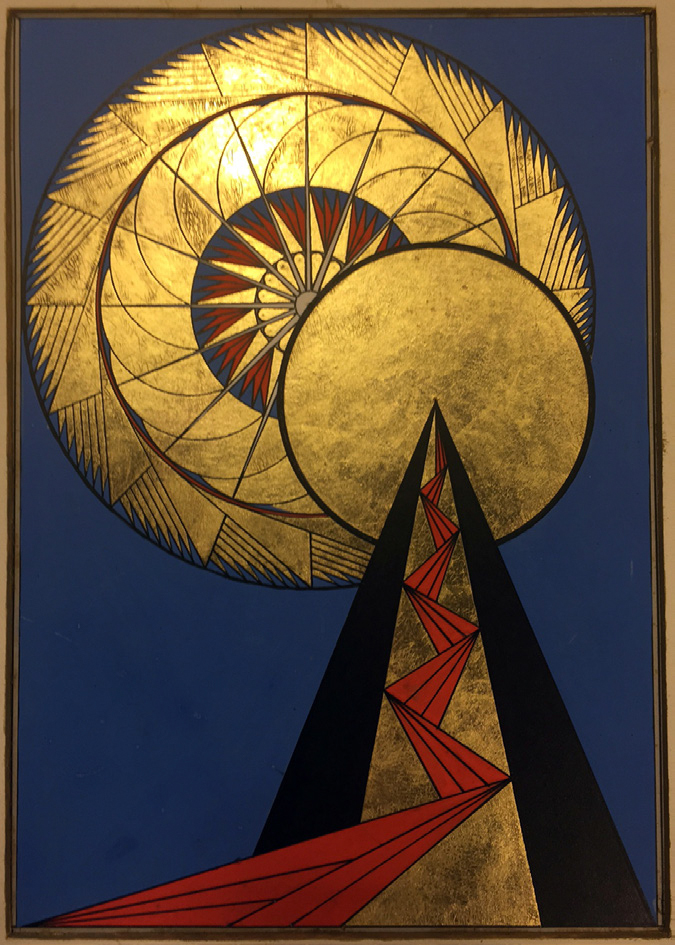
The seat of the Angel – and the Agathodaimon – this centre is also the ‘heart’ of our magical system. Full realisation of the consciousness of this sphere is a truly exalted state, but its virtues should be sought from the very start: compassion, cultivation of the will, self-government (enkrateia, as Hermes calls it in C.H. XIII). Along with Tabor meditation, this rite helps us ‘dwell in the heart’, allowing its virtues to become the ground of our ordinary life.
The Orbis Solis is also the athanor, the crucible of the great work, in which the alchemical transformation of the self takes place. This transformative power is not only inward. Our method of consecration, blessing or projection of force involves calling power through the central channel, and projecting it outwards from the heart through the hands; this formula is widely adaptable, as a means of exorcism or in the induction of elevated states in others.
The heart is the meeting place of celestial and earthly forces in many esoteric systems, and the place of regeneration. Greeting of Earth and Heaven! Full treatment of the Holy Guardian Angel is beyond our scope here, but it is worth stressing that the experience of the Angel is the beginning of a new phase of magical life, not its final summit. Nor does the rising of the inner sun dispel all shadows forever. An emphasis on compassion and mercy (rahamim, רַחֲמִים) as the true synthesis of loving-kindness (chesed, חֶסֶד) and judgement (din, דִּין) is typical of traditional writing on this sphere; it is a good virtue for magicians to cultivate, both for themselves and others.
The ‘I’, the rational part of the soul, has its seat here. Our waking attention can be turned this way and that, ensnared in this or that trend or marketing spell, prisoner of our own compulsion or delusion, or torn between the joys of the body and the yearning of the spirit. One fruit of the Rousing is that it begins to move these contradictions into alignment: a foundation for the discovery (or, better, refinement) of the True Will. This process can bring us face-to-face with patterns of behaviour or masks of the self which are actively damaging, or simply no longer serve us. Shedding these can be painful, even if ultimately liberating.
The qlifot of Tiphareth are the tagaarim, the rebukers (from גָּעַר). This is a good image of the peculiar vice of this sphere: solar kingship gone sour, unleavened by compassion, obsessed by others’ perceived errors and flaws. It is the vice of misused magical or spiritual attainment as a means of despotism, or control of others. It is more common among magicians than it should be. When it is not more widely destructive it is simply sad. There are some obvious causes: skimping on basic, fundamental works of balance and integration, or a total divorce of the magical from the religious or devotional, or a complete lack of introspection. Even with those matters well attended, the powerful, expansive effect of this sphere can pose risks as well as profound rewards.
The Rousing does not activate the centre at the solar plexus, though that centre is used in a range of subtle body techniques to induce astral projection or sharpen the psychic centres. It sits, effectively, between moon and sun. Sometimes called the ‘Mons Luminis’, it is also the focus of the Tabor meditation technique.
Cornua Lunae
Horns of the Moon. Yesod.
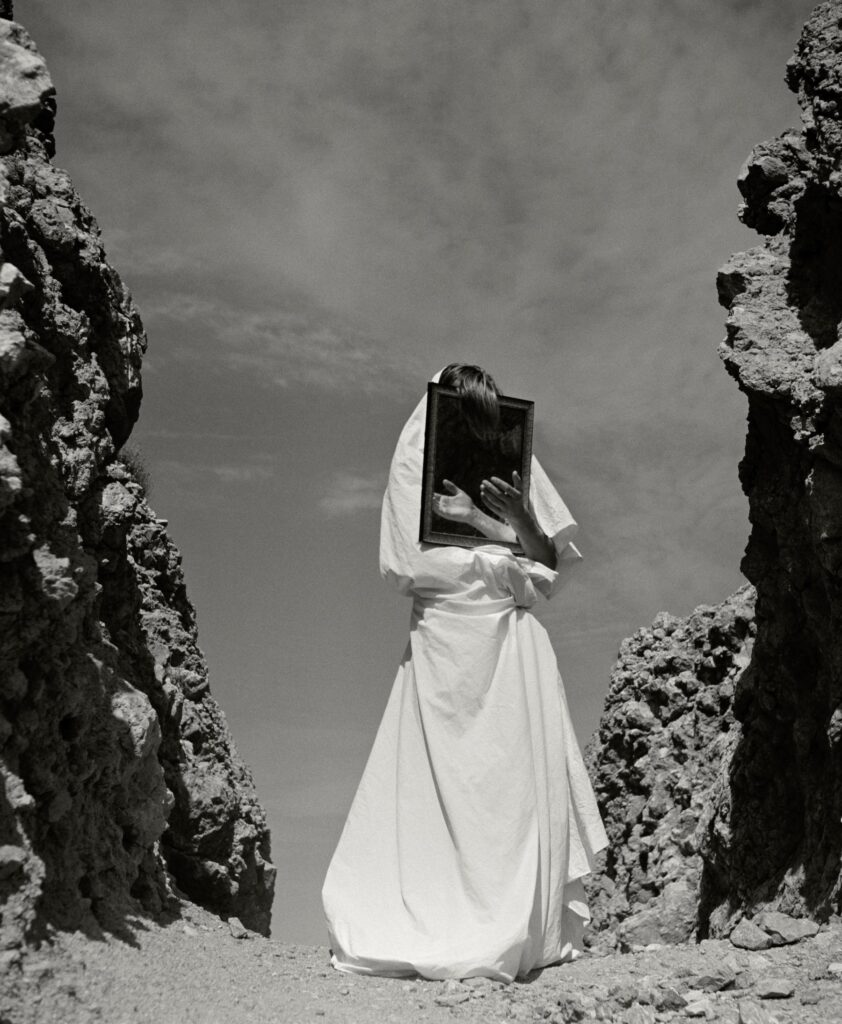
Throne of the Moon, great governor of tides, emotions, dreams, illusion and desire. Typically visualised as whirling rapidly, this sphere is the centre of all desire, libido and psychic energy. (‘Libido’ means the general, outwardly-directed conscious impulse, of which sexual desire is one instance; I personally perceive the sphere moving more slowly when tired.) Much of the work of magic, including the astral image-building of the Rousing, properly belongs to this sphere. Psychic images, dreams, spiritual communication, divination are only the most obvious. Learning to consciously operate on this level is key to effective magical work.
It is not unusual for those mastering the Rousing to experience an upswing in libido, often taking sexual form. This is partly because our culture remains very conflicted, repressed and contradictory about sex. But there are other reasons: sexual desire is one of the few ‘normal’ states of consciousness which involves intensely directed psychic energy; for most of us it is also the most familiar expression of that energy. It can also come very close to some magical states of consciousness. Many traditions therefore give instruction about sexuality, whether requiring periods of abstention, celibacy or (conversely) stable marriage or relationships. What is essential is the avoidance of compulsion or obsession, and the development of a personal via media.
Yet this sphere is about much more than sex: it is about the great tides of emotion and desire which constitute human existence. Every time we dream or imagine some future for ourself, some possibility or hope, we are working in this sphere. Some of these are idle, some rise and pass like eddies in a current. A result of serious magical work is an ability to discern between our enduring, important desires and the reflexes inherited from family, culture or social expectation. This discernment allows us to detach from our various identities, while also embracing them fully as masks or means of play in the world. One of its gifts in ordinary life is an increasingly joyful participation in the world’s simple delights.
The risk of this sphere is that we become entranced, fascinated by its images and shadows. The traditional demonic image of this sphere, the satyr-like Seirim (שעירים) suggests humanity given over to the merely compulsive, instinctive or animal, for whom too much is never enough. Yet there is also the individual who lives in dreams, in the not-yet or the one-day, or who takes no action to make dreams real; this type is often found in ‘spiritual’ communities. Less common, though a particular risk for magicians, is a confusion of levels, where elements of the personal subconscious seep into our spiritual work and seem to take on exterior, objective existence – often of a very flattering kind. The skill of discernment is a spiritual gift!
Much ink has been spilled on ‘astral hygiene’ over the years. Avoiding paranoia and scrupulosity is at least as important as basic defence. Combining the Wards and the Rousing should suffice in most cases, and will also develop a strong intuitive sense of dangerous or invidious situations.
Instita Splendens
Shining Hem. Malkuth.
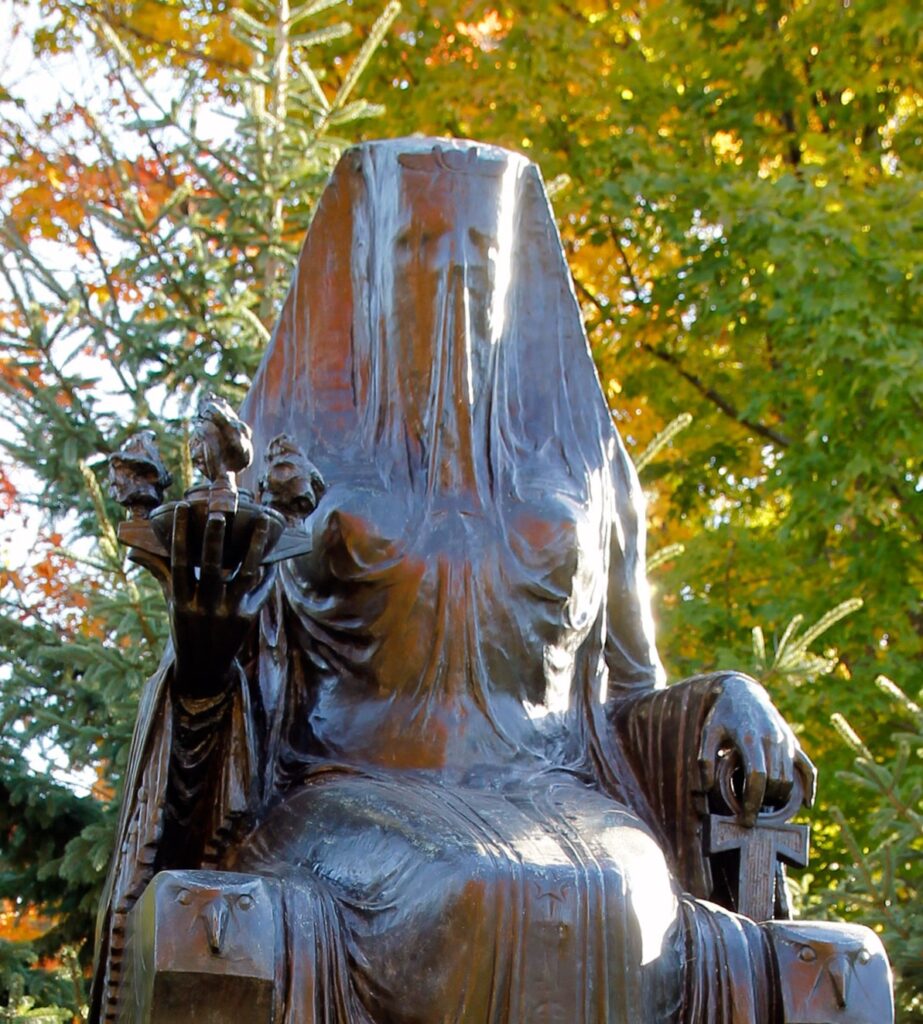
A deeply suggestive and mysterious title: we are immediately reminded of the King’s Daughter (Psalm 45: 13-14) in garments edged with goldwork and ‘bordered with variety’. In the Qabalah, this is often read as a reference to the Shekinah, awaiting union with her bridegroom; the final letter Heh of the Tetragrammaton, the manifest world. The checker-pattern floor of many Western Mystery Tradition temples echoes this theme.
Two other hems are significant here: the hem of the Veil of Isis, which ‘no mortal hath ever lifted’, and the hem of Christ’s garment in Luke 8, from which ‘power [δύναμιν] went out’ and healed the woman who touched it. The imagery of the sphere (in our usage) very strongly recalls the link between the Great Mother of Binah and the Lower Mother of Malkuth, and its powerful magical image – the Veiled Maiden – repays meditation.
This is the sphere of the material world, and the physical body. The Ogdoadic Tradition does not teach a myth of the fall, with its tendency to view the world as a prison, tomb or degradation of the soul. Yet humanity’s ordinary state is doubtless one of spiritual hunger, disorientation, imbalance and inconstancy. The Hermetic anthropology of the Poimandres, which speak’s of our mixed nature, and the subjection of the individual soul to the seven ‘governors’ is more instructive. Much of the initial work of the magician is rectification and integration of this state. The Rousing is an essential adjunct to this process.
We are incarnate beings. Even our most exalted spiritual states are experienced as incarnate beings, and even our ecstasies return us ultimately to our bodies. Yet many occultists treat their physical bodies dreadfully: as afterthoughts, in dissipation, self-punishment, poisoning, overindulgence. Overcoming such attitudes, which often arise from deep injury, requires an alloy of will and compassion – but they must be overcome, or spiritual progress will be built on a foundation of sand.
The spiritual experience associated with this sphere is sometimes said to be the ‘Vision of the Holy Guardian Angel’: not the congress (sustasis) which marks the experience of ‘Knowledge and Conversation’ proper, but the sudden – sometimes fleeting – vision of the path unfolding before us, the dawn gleaming in the distance. The so-called ‘Guardian at the Threshold’ also prowls the edges of this sphere. This experience, very common for beginners, is composite: a mix of daunted fear at the work and scope of transformation, a first experience of spiritual ‘dryness’, a flagging of enthusiasm and commitment. Sometimes this can manifest quite explicitly, as a feeling of being pushed back from the path. These two spiritual phenomena are connected: this Guardian is none other than our own Genius, seen in the distorting mirror of our own fears and self-misconceptions. Only serene determination to face it will allow us to pass through it, to find it passes like a shadow.
In a beautiful image of the late Platonists, the universe is conceived as akin to an endless cycle of breathing, proceeding from and returning to the One. Malkuth is the sphere of turning. So it is sometimes common for magicians to think they have ‘completed’ the work of Malkuth early on, and need pay no attention to the Kingdom and its wonders. But the Kingdom is where we have our being, and the work of the Tree is not so simply linear. We are incarnate beings, and we never complete our turning in the course of incarnation. Thus the magician turns her face to the Sun every morning.
The Caduceus
The rite ends with a circulation of energies, flux and reflux, through the subtle body. These two currents, visualised in red and white, have many symbolic analogues throughout the tradition: for ‘She is the form in all things, and He is in all things the breath of life’. Meditation on this dynamic, alchemical pairing offers deep rewards. Only two points need be stressed here: though the currents are visualised as disappearing into the Flos Abysmi, it is better to think of them as transformed through this great transitional gate. They energise and balance the entire subtle body. Second the rite first draws power down towards the earth, then receives it transformed, amplified, and drawn upwards. It should leave the operator energised and ‘awoken’. This pattern of descent and ascent of power is a pattern repeated through a number of A.S. magical techniques, and is itself worth meditation, reflection and experiment.
Theurgic Prayer
This essay has dwelt on the first formula of the Clavis, because it is simply the most important technique a beginner can master, and it has dwelt especially on the states of consciousness associated the gate-spheres. The formula is also undoubtedly the key to effective practical magic. A word on its developments: as William Stoltz notes, the final, advanced form of CRP-1 involves the installation of the Briatic god-images in the spheres. This is a powerful theurgic technique not to be employed carelessly, or on weak foundations. The other formulae of the CRP, including the alchemical, transformative CRP-2, are also essential. Yet all are built on this foundation.
At the conclusion of both forms of the CRP, I find my consciousness often returning to, and resting at the heart centre. Sometimes I find myself in a state alluded to by Damascius, the last scholarch of the Platonic Academy, in a rich saying which alludes to the grace and serenity associated with theosis. It is a good note to end with:
Αὐτὴν δὲ τὴν ψυχὴν ἐν ταῖς ἱεραῖς εὐχαῖς πρὸς ὅλον τὸ θεῖον πέλαγος ἔλεγε τὰ μὲν πρῶτα συναγειρομένην ἀπὸ τοῦ σώματος εἰς ἑαυτήν, αὖθις δὲ εξισταμένην τῶν ἰδιων ἠθῶν καὶ ἀναχωποῦσαν ἀπὸ τῶν λογικῶν ἐννοιῶν ἐπὶ τὰς τῷ νῷ συγγενεῖς, ἐκ δ’ αὖ τρίτων ἐνθουσιῶσαν καὶ παραλλάττουσαν εἰς ἀήθη τινὰ γαλήνην θεοπρεπῆ καὶ οὐκ ἀνθρωπίνην.
He used to say that when the soul is in holy prayer facing the mighty ocean of the divine, at first, disengaged from the body, it concentrates on itself; then it abandons its own habits, withdrawing from logical into intuitive thinking; finally, at a third stage, it is possessed by the divine and drifts into an extraordinary serenity befitting gods rather than men.
[Fr.22 Athanassiadi]
